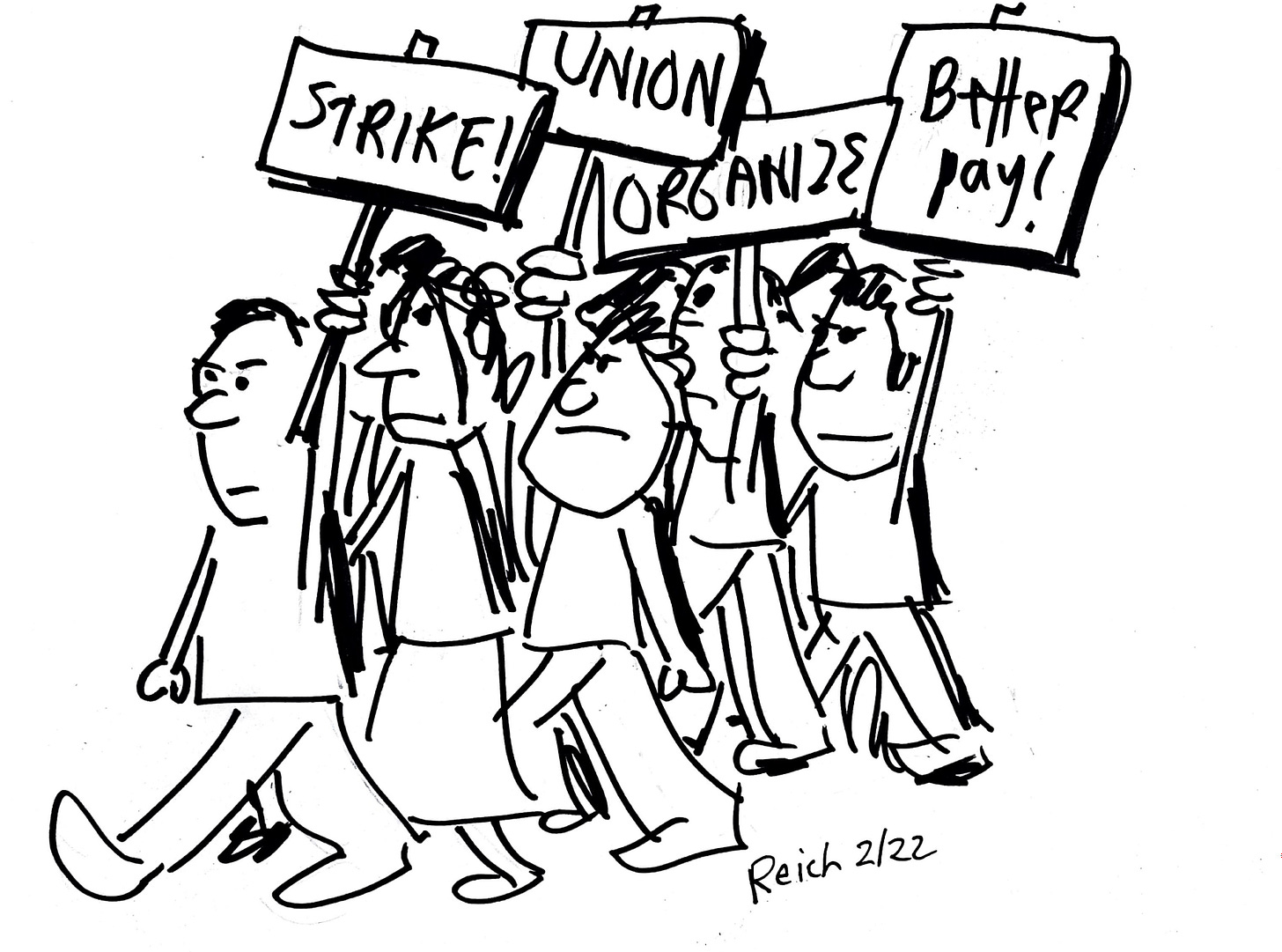What Really Happened to the American Dream? (Why American capitalism is so rotten, Part 2)
Friends,
Welcome back to the second of our Friday discussions about the common good and American capitalism.
Today I want to address the disappearance of what was once called the “American dream.” Its disappearance provides an important clue about why Trumpism continues to attract so many.
During the 1950s and 1960s, my father, Ed Reich, owned a shop on the main street from which he sold women’s clothing to the wives of factory workers.
This time of year reminds me of his anxious dependence on holiday sales. Between Thanksgiving and Christmas, he needed to earn enough to pay the bills and have a sufficient sum to carry us through the first part of the following year.
We weren’t rich but never felt poor, and our standard of living rose steadily through the 1950s and 1960s — as factory workers and their spouses did better and better.
This was an era when the income of a single factory worker or schoolteacher or baker or salesman or mechanic was enough to buy a home, have two cars, and raise a family.
FOR THREE DECADES after World War II, America created the largest middle class the world had ever seen. During those years, the earnings of the typical American worker doubled, just as the size of the American economy doubled.
Over the last 40 years, by contrast, the size of the economy has more than doubled again, but the earnings of the typical American have barely budged (adjusted for inflation).
Then, the CEOs of large corporations earned an average of about 20 times the pay of their typical worker. Now, they rake in over 300 times.
In the 1950s and 1960s, the richest 1 percent of Americans took home 9 to 10 percent of total income. Today they take home more than 40 percent.
Then, the economy generated hope. Hard work paid off. The living standards of most people improved through their working lives. Their children enjoyed better lives than they had. Most felt that the rules of the economic game were basically fair.
Although many women, Black people, and Latino people were still blocked from getting a fair share of the economy’s gains, the nation committed itself to changing this. New laws guaranteed equal opportunity, barred discrimination, promoted affirmative action, and expanded educational opportunity for all.
Today, confidence in the economic system has sharply declined. Its apparent arbitrariness and unfairness have undermined the public’s faith in it. Cynicism abounds. Equal opportunity is no longer high on the nation’s agenda.
To the contrary, our economic and political system now seems rigged.
That’s because it is.
THE THREAT TO CAPITALISM is no longer communism or fascism but a steady undermining of the trust modern societies must depend on.
When most people stop believing they and their children have a fair chance to make it, the tacit social contract begins to unravel. And a nation becomes susceptible to demagogues such as Donald Trump.
We have the power to change all this, recreating an economy that works for the many rather than the few. But to determine what must be changed, and to accomplish it, we must first understand what happened and why.
The conventional explanation is that globalization and technological change have made most Americans less competitive. The tasks we used to do can now be done more cheaply by lower-paid workers abroad or by computer-driven machines. Presumably, artificial intelligence will accelerate this trend.
The conventional solution — at least among people who call themselves liberals, Democrats, and progressives — has been an activist government that raises taxes on the wealthy, invests the proceeds in excellent schools and other means people need to get ahead, and redistributes to the needy.
This solution has been vigorously opposed by people who called themselves conservatives and Republicans, who believe the economy will function better for everyone if government is smaller and if taxes and redistributions are curtailed.
BUT THE CONVENTIONAL EXPLANATION for what has happened overlooks a critically important phenomenon — the increasing concentration of political power in a corporate and financial elite that has been able to alter the rules that run the economy.
And the conventional solution is in some ways beside the point, because it takes insufficient account of the corruption of government by these moneyed interests.
The debate over the merits of the “free market” versus an activist government has diverted attention from how the market has come to be organized differently from the way it was a half-century ago, why its current organization is failing to deliver the widely shared prosperity it delivered then, and what the basic rules of the market should be.
The diversion of attention is not accidental.
Many of the most vocal proponents of the “free market” — including executives of large corporations and their ubiquitous lawyers and lobbyists, denizens of Wall Street and their political lackeys, and numerous multimillionaires and billionaires — have for many years been actively reorganizing the market for their own benefit and would prefer these issues not be examined.
MARKETS DEPEND for their very existence on rules governing property (what can be owned), monopoly (what degree of market power is permissible), contracts (what can be exchanged and under what terms), bankruptcy (what happens when purchasers can’t pay up), labor unions (how much power should workers have), and how all of this is enforced.
Such rules do not exist in nature. They must be decided upon, one way or another, by human beings.
These rules have been altered over the past four decades as large corporations, Wall Street, and wealthy individuals have gained increasing influence over the political institutions responsible for them.
Simultaneously, centers of countervailing power that between the 1930s and 1980s enabled America’s middle and lower-middle classes to exert their own influence — labor unions, small businesses, family farms, and political parties anchored at the local and state levels — have withered.
The consequence has been a market organized by those with great wealth for the purpose of further increasing their wealth.
This has resulted in ever-larger upward distributions inside the market, from the middle class and poor to a minority at the top. Because these distributions occur inside the market, they have largely escaped notice.
As we’ll see, the meritocratic claim that people are paid what they are “worth” in the market is a tautology that begs the questions of how the market is organized and whether that organization is morally and economically defensible.
In reality, income and wealth increasingly depend on who has the power to set the rules of the game.
CEOs of large corporations and Wall Street’s top traders and portfolio managers effectively determine their own pay, advancing market rules that enlarge corporate profits while using inside information to boost their fortunes.
Meanwhile, the pay of average workers has gone nowhere because they have lost countervailing economic power and political clout. The simultaneous rise of both the working poor and non-working rich offers further evidence that earnings no longer correlate with effort or with the common good.
All of this has brought us Donald Trump and America’s lurch toward fascism.
The underlying issue is not the size of government. It’s whom the government is for.
The remedy is for the vast majority to regain influence over how the market is organized. This will require a new countervailing power — allying the economic interests of the majority who have not shared the economy’s gains.
The battle pitting the “free market” against government is needlessly and perversely preventing such an alliance from forming.
The biggest political divide in America in years to come will be between, on the one side, the complex of CEOs of large corporations, top executives and traders at Wall Street banks, private equity and hedge-fund managers, and other moneyed interests who have fixed the economic and political game to their liking. And on the other side, the vast majority who have been left behind.
Some of the people who have been left behind are susceptible to the lies and bigotry of neofascists like Trump.
But the answer is not to give up on democracy.
To the contrary, the only way to reverse course is for the vast majority who now lack influence over the rules of the game to become organized and unified, in order to reestablish the countervailing power that was the key to widespread prosperity five decades ago.
IF WE DISPENSE with mythologies that have distracted us, we can make the system work for most of us rather than for only a relative handful.
History provides some direction as well as some comfort, especially in America, which has three times in our short history readapted the rules of the political economy to create a more inclusive society, while restraining the political power of wealthy minorities at the top.
In the 1830s, the Jacksonians targeted the special privileges of elites so the market system would better serve ordinary citizens.
In the late 19th and early 20th centuries, progressives enacted antitrust laws to break up the giant trusts, created independent commissions to regulate monopolies, and banned corporate political contributions.
In the 1930s, New Dealers limited the political power of large corporations and Wall Street while enlarging the countervailing power of labor unions, small businesses, and small investors.
The challenge is not just economic but political. Economics and politics cannot be separated.
It’s time for the Democratic Party and its leaders to give full-bodied voice to the forces — labor unions, small businesses, worker cooperatives, worker-owned businesses, family farmers, nonprofits, bottom-up politics, and all of us who are still committed to the common good — that together can countervail the overwhelming power of the big monied interests.
The issues we’ll discuss over the next eight weeks harken back to an earlier tradition of inquiry. The field used to be called “political economy” — the study of how a society’s laws and political institutions relate to a set of moral ideals. A fair distribution of income and wealth was a central topic.
In the eighteenth century, it was termed moral philosophy. (Adam Smith called himself a moral philosopher).
We must now return to the moral questions at the heart of politics and economics.
***
Next Friday, we’ll examine what I consider to be the biggest and most dangerous myth about capitalism, which has prevented Americans from understanding who is controlling it.
Thank you once again for joining me on this expedition. Please add your comments, take part in our discussion, and share with others.
Subscribers to this newsletter are keeping it going. If you are able, please consider a paid or gift subscription.












About the growth in the economy
I was an engineer - I spent decades improving productivity - in 10 years we doubled the output per man
Most of that was by working smarter - implementing good ideas
About half of the good ideas (along with some stinkers) came from the shop floor - the other half from the engineers
Not a single solitary good idea came from the executives in all the decades I was doing that
G.O.P. = Grand Oligarchy Party
When the Republicans get back in power they will
Mandate the following bills:
* Eliminating the Entitlement Programs, social security, Medicare, etc…..
* Repealing the Affordable Care Act (Obamacare)
* Promoting voter suppression
* Eliminating all gun laws
* Locking up political opponents
* Completely outlaw abortion
* Punishment for the woman who has one
* Eliminating LGBTQ
* Deport all undocumented immigrants
* Establishment of Christian Nationalism
* More tax cuts for the rich 🤑